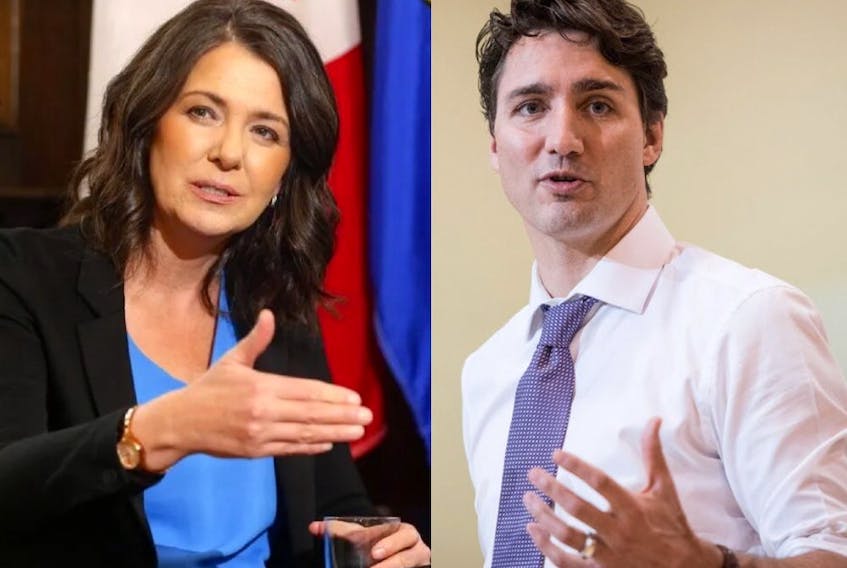Alberta
Premier Smith negotiates publicly with PM Trudeau: cancel ‘just transition’ and collaborate on carbon capture

Letter from Premier Smith to Prime Minister Trudeau
Premier Danielle Smith invites Ottawa to collaborate with Alberta on carbon capture, utilization and storage investment and halt introduction of Just Transition legislation and oil and gas emissions cap.
Dear Prime Minister:
I am writing in follow up to our meeting of February 7th, during which we discussed the need for the Government of Canada to halt introduction of the proposed Just Transition legislation and implementation of unachievable targets and measures under the federal Emissions Reduction Plan (ERP) such as the Clean Electricity Regulations (CER) and oil and gas sector emissions cap.
As a much more productive alternative, I invited your government to agree to commencing a collaborative effort between Ottawa and Alberta to develop a series of cooperative initiatives to attract investment and workers into Alberta’s emerging, conventional and non-conventional energy sectors while substantially reducing Canada’s and Alberta’s net emissions.
In that meeting, you expressed a willingness to pursue this course of collaborative action, but requested it be commenced promptly. The morning following my return to Alberta, I met with several of my ministers regarding this issue and can advise as follows.
The Government of Alberta is prepared to work with the federal government on a coordinated approach for a carbon capture, utilization and storage (CCUS) incentive program for the purpose of net emissions reductions in our province while attracting billions in new investments for Alberta-based oil and gas projects, electricity, manufacturing and other sectors.
To this end, we propose coordinating a federal CCUS income tax credit with an expansion of our current Alberta Petrochemicals Incentive Program (APIP) to include CCUS projects. This new incentive program would be in addition to the over $1.8 billion already invested into CCUS projects across the province by the Government of Alberta as well as our province’s additional implicit contribution to CCUS made through our current royalty regime.
Our government is also willing to discuss with your government expanding this coordinated approach to incentivizing other emerging emission reducing technologies as well, though we suggest beginning with agreement on a coordinated CCUS incentive program, so we are able to establish a successful foundation on which to build upon.
To this end, I request that we immediately create a federal/provincial minister-led working group with the objective of reaching agreement on a coordinated provincial-federal CCUS incentive program in the coming weeks.
Prime Minister, I must make it clear that the above invitation for cooperation and collaboration on this CCUS proposal and other energy and climate initiatives comes with one non-negotiable condition.
It is that the federal government refrain from introducing any new federal legislation or policies that materially impact Alberta’s oil and gas resource development, management or workforce participation without the full involvement, consultation and consent of Alberta.
This includes the contemplated Just Transition legislation and implementation of unachievable targets and measures under the federal Emissions Reduction Plan (ERP) such as the Clean Electricity Regulations (CER) and oil and gas sector emissions cap.
Each of these initiatives, as currently understood, would pose an unconstitutional and existential threat to the Alberta economy and the jobs of hundreds of thousands of Albertans.
As an alternative to this policy package of economic destruction, Alberta proposes working collaboratively with the federal government on aggressively advancing emission reducing technologies in Alberta as outlined above while simultaneously increasing export of LNG through the lens of replacing higher emitting fuels around the world to meet aggressive but achievable overall emissions reduction in Alberta’s oil and gas and other sectors. Ideally, our government would like to incorporate these collaborative federal-provincial initiatives into our soon-to-be-released Alberta Emissions Reduction and Energy Development Plan.
I must once again emphasize to you, Prime Minister, that although Alberta is willing to work as an active partner with the federal government on a coordinated approach to reducing Alberta’s and Canada’s net emissions, under no circumstances will our province accept the imposition of arbitrary and unachievable targets or policies that spell the end of meaningful long-term investment in Alberta’s energy sector, and as a result, the imminent phase out of Alberta’s largest industry. In such circumstances, our government would have no other choice but to oppose these destructive policies using every tool at our disposal in order to protect Albertans, their jobs and our province’s future.
Prime Minister, this issue is far larger and more important than you or I. There are literally hundreds of billions in public revenues and investments, and millions of jobs, riding on Alberta and Ottawa working together – instead of in conflict – on energy and environmental issues to create an attractive and certain investment climate that millions around the world want to invest in and move to.
Failure to do so will not only undermine Canada’s prosperity by driving billions in energy investment and revenue out of Canada and into the hands of the world’s most brutal and undemocratic regimes, but will also result in increased energy poverty and food insecurity in many of the world’s most impoverished countries, a loss of our nation’s global influence, and most ironically, an increase in the world’s global emissions due to an increased use of coal, as opposed to LNG, by developing nations to meet increasing world demand for electricity.
Canada has the potential to become a global energy superpower with all of the economic and political influence for good that such standing would grant us. We can and must seize this opportunity without delay. Please come to the table and work collaboratively with Alberta on likely the most important economic issue facing this country in a generation.
I look forward to reading your response and to learning of the appointment of your government’s side of the federal/provincial minister-led working group for the CCUS incentive program so that our two governments can take our first steps in this critical collaborative effort.
Alberta
They never wanted a pipeline! – Deputy Conservative Leader Melissa Lantsman

From Melissa Lantsman
Turns out the anti-development wing of the Liberal Party never stopped running the show.
Today, we’ll see if the Liberals vote for the pipeline they just finished bragging about.
Spoiler: they won’t. Because with the Liberals, the announcements are real, but the results never are.
Alberta
Premier Smith: Canadians support agreement between Alberta and Ottawa and the major economic opportunities it could unlock for the benefit of all

From Energy Now
By Premier Danielle Smith
Get the Latest Canadian Focused Energy News Delivered to You! It’s FREE: Quick Sign-Up Here
If Canada wants to lead global energy security efforts, build out sovereign AI infrastructure, increase funding to social programs and national defence and expand trade to new markets, we must unleash the full potential of our vast natural resources and embrace our role as a global energy superpower.
The Alberta-Ottawa Energy agreement is the first step in accomplishing all of these critical objectives.
Recent polling shows that a majority of Canadians are supportive of this agreement and the major economic opportunities it could unlock for the benefit of all Canadians.
As a nation we must embrace two important realities: First, global demand for oil is increasing and second, Canada needs to generate more revenue to address its fiscal challenges.
Nations around the world — including Korea, Japan, India, Taiwan and China in Asia as well as various European nations — continue to ask for Canadian energy. We are perfectly positioned to meet those needs and lead global energy security efforts.
Our heavy oil is not only abundant, it’s responsibly developed, geopolitically stable and backed by decades of proven supply.
If we want to pay down our debt, increase funding to social programs and meet our NATO defence spending commitments, then we need to generate more revenue. And the best way to do so is to leverage our vast natural resources.
At today’s prices, Alberta’s proven oil and gas reserves represent trillions in value.
It’s not just a number; it’s a generational opportunity for Alberta and Canada to secure prosperity and invest in the future of our communities. But to unlock the full potential of this resource, we need the infrastructure to match our ambition.
There is one nation-building project that stands above all others in its ability to deliver economic benefits to Canada — a new bitumen pipeline to Asian markets.
The energy agreement signed on Nov. 27 includes a clear path to the construction of a one-million-plus barrel-per-day bitumen pipeline, with Indigenous co-ownership, that can ensure our province and country are no longer dependent on just one customer to buy our most valuable resource.
Indigenous co-ownership also provide millions in revenue to communities along the route of the project to the northwest coast, contributing toward long-lasting prosperity for their people.
The agreement also recognizes that we can increase oil and gas production while reducing our emissions.
The removal of the oil and gas emissions cap will allow our energy producers to grow and thrive again and the suspension of the federal net-zero power regulations in Alberta will open to doors to major AI data-centre investment.
It also means that Alberta will be a world leader in the development and implementation of emissions-reduction infrastructure — particularly in carbon capture utilization and storage.
The agreement will see Alberta work together with our federal partners and the Pathways companies to commence and complete the world’s largest carbon capture, utilization and storage infrastructure project.
This would make Alberta heavy oil the lowest intensity barrel on the market and displace millions of barrels of heavier-emitting fuels around the globe.
We’re sending a clear message to investors across the world: Alberta and Canada are leaders, not just in oil and gas, but in the innovation and technologies that are cutting per barrel emissions even as we ramp up production.
Where we are going — and where we intend to go with more frequency — is east, west, north and south, across oceans and around the globe. We have the energy other countries need, and will continue to need, for decades to come.
However, this agreement is just the first step in this journey. There is much hard work ahead of us. Trust must be built and earned in this partnership as we move through the next steps of this process.
But it’s very encouraging that Prime Minister Mark Carney has made it clear he is willing to work with Alberta’s government to accomplish our shared goal of making Canada an energy superpower.
That is something we have not seen from a Canadian prime minister in more than a decade.
Together, in good faith, Alberta and Ottawa have taken the first step towards making Canada a global energy superpower for benefit of all Canadians.
Danielle Smith is the Premier of Alberta
-

 espionage2 days ago
espionage2 days agoWestern Campuses Help Build China’s Digital Dragnet With U.S. Tax Funds, Study Warns
-

 Bruce Dowbiggin1 day ago
Bruce Dowbiggin1 day agoWayne Gretzky’s Terrible, Awful Week.. And Soccer/ Football.
-

 Opinion2 days ago
Opinion2 days agoThe day the ‘King of rock ‘n’ roll saved the Arizona memorial
-

 Focal Points2 days ago
Focal Points2 days agoCommon Vaccines Linked to 38-50% Increased Risk of Dementia and Alzheimer’s
-

 Health1 day ago
Health1 day agoCDC Vaccine Panel Votes to End Universal Hep B Vaccine for Newborns
-

 Business1 day ago
Business1 day agoCanada invests $34 million in Chinese drones now considered to be ‘high security risks’
-

 Agriculture2 days ago
Agriculture2 days agoCanada’s air quality among the best in the world
-

 Business1 day ago
Business1 day agoThe EU Insists Its X Fine Isn’t About Censorship. Here’s Why It Is.








